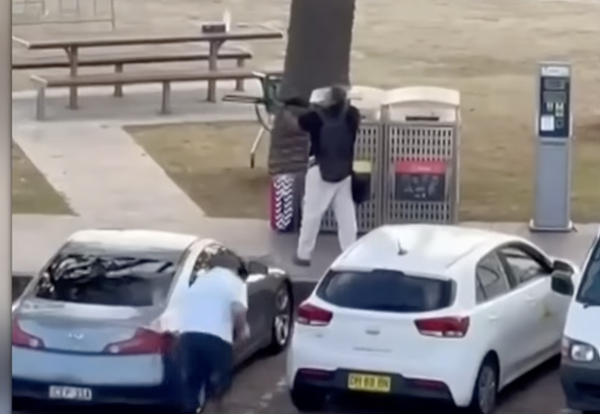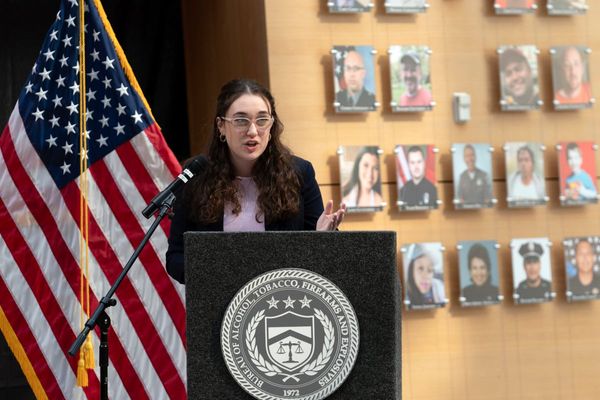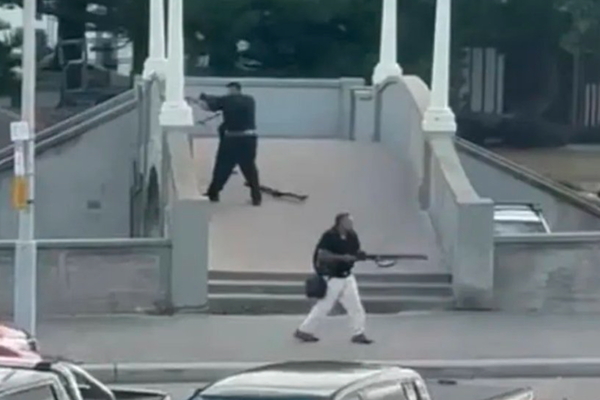
When they lifted the enormous statue of the Confederate general Robert E Lee from his pedestal and set him on the ground in Richmond, Virginia, on Wednesday, it was symbolically huge to me. On high, he was undeservedly venerated.
And for years of walking under him on Monument Avenue, going about my day, I always felt the city was in an embarrassing time warp, unable to completely shake its status as the former capital of the Confederacy.
I loved hearing the happiness and excitement from the large intergenerational, mostly Black and white crowd as Lee was brought down, to chants of “na, na, na … goodbye.”
A white mom to my left, standing in front of the barricade, had given her 10-year-old white daughter the day off from school to watch Lee come down, which was perhaps more valuable than any history lesson she could have received that day in class.
And the enlightened and honest conversation I imagined the pair having that evening over dinner gave me hope.
Crews first secured the statue with chains before it was lowered by crane, symbolically binding the likeness of a man who should have been imprisoned for treason but was instead pardoned by President Abraham Lincoln.
Workers with humming power saws divided it into two large pieces to ease transport, seemingly dashing future aims to use the statue as a rallying point for white supremacist protests – a wise, if not intentional, measure.
And with that, Richmond took a huge step toward healing from its shame.
Mostly, I’m hopeful it holds us more accountable to make change in a city with a poverty rate of more than 23%, struggling schools and a Black and brown population that suffers most.
Right now, the world’s eyes are on us and we are motivated. But what happens when things settle and more choices to move us forward – opportunities to put in place policies that protect Black and brown bodies and ensure equity in this city – are made?
Another observer in the crowd shouted that, to him, removing Lee was “just a placebo” and that the powers that be want Black folks to just be happy the statue is down, that real change will never come. Let’s not prove this witness right.
I’d always thought of Monument Avenue, where Lee’s and other Confederate leaders’ statues had stood for more than a century – with Lee the last to come down – as a huge embarrassment.
It was a giant consolation prize to losers and traitors. I tend to use dark humor as a salve, so it was always a little amusing to me, and of course ironic, that the statues were erected 25 years after Lee’s surrender at Appomattox. (Guys, give it up already.)
But the painful part is that those monuments remained, unaltered for another 131 years, due to tone deaf or uncaring politicians, and an out-of-touch older, white establishment.
Why is it that conversations about “contextualizing” the avenue – adding plaques to explain the history of the civil war and perhaps of the movement to lionize Confederate figures – have happened only in such recent history? Contextualization isn’t the best thing to do – especially considering that a woman was murdered in Charlottesville, Virginia, while counterprotesting a “Unite the Right” rally at the feet of another Lee statue in 2017. (That statue finally came down this July.) But contextualization would have been better than just leaving the statues there.
I moved to Richmond from my home town Newport News, 80 miles east, in 2009 to attend Virginia Commonwealth University, a large public college with a sprawling campus that blends into the city.
Its diverse and eclectic main campus is in the same neighborhood as the statues, a beautiful district said to have the largest collection of intact Victorian homes in the US.
The city has a lot of cool selling points, but the monuments were certainly not one of them. They indicated a community simultaneously moving forward while stubbornly staying put.
And I always felt the need to explain them to outsiders. I remember a young Japanese visitor, camera around her neck, approaching me on campus asking for directions to Monument Avenue.
And I just thought, wow, what is she going to think about all this? It was the first time I realized Virginia’s shame was a tourist attraction.
And that shame was compounded for me during the UCI road world championship cycle races in 2015, when tourists from around the country and world descended on Richmond.
Of course, there were the news stories about foreigners scratching their heads about why Lee and the other traitors were honored here.
And then we just went on with our business, said “try our food and amazing craft beers”. I know I did; I was one of many reporters covering the race, and I just moved on to the next development.
And I’m depressed, ashamed and livid that it took the murder of George Floyd by a white police officer in Minneapolis in 2020 to remove the monuments, these giant blights that loomed above us.
I guess I just thought they would always be there. It was almost like I had accepted that I was never going to fully matter in this country, as a Black woman. How much were things really going to change, anyway?
I am nervous about the future. The huge empty pedestal, now covered in Black Lives Matter graffiti, is still there.
I’m almost waiting for Richmond to mess it up again, and not put something there with meaning.
I’m hoping we can be like Mexico City: this week they announced they will replace a statue of Christopher Columbus with a statue of an Indigenous woman.
In the past, Richmond’s decisions haven not been so self-aware.
We have a statue of tennis champion and Black Richmond native Arthur Ashe on Monument Avenue, alongsidethe Confederates before the traitors were removed. How did the authorities not see this as insulting? Was it just a misguided way to placate us, by somehow trying to honor “all” at once?
I feel a strong sense of protection for the makeshift protest memorials that sprang up in the traffic circle where Lee’s statue stood, now known unofficially as Marcus David-Peters circle in honor of the Black man who was a high school teacher and an alumnus from my university who was killed by Richmond police in 2018.
These memorials, dedications to Black lives, were collected and catalogued by the Library of Virginia – time capsules in plastic – and I worry they may be shut away in archives.
I’m hoping they’re instead displayed, so we can remember what it was all for. I hope equally that we will continue to demand laws and policies that respect the agency and right to safety of Black bodies. I will uphold my end of the deal as a reporter routinely covering social justice and poverty.
Otherwise, the removal of Lee will be its own pointless, modern-day consolation prize.
• This article was amended on 10 September 2021 to correct a spelling error in the headline.







